The Czech Republic's Counterpart? - Slovakia and the Slovak Language
November 6, 2017
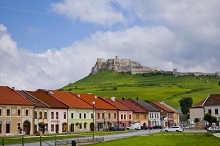
Hello, I'm Yosshi. I entered the translation business two years ago, dreaming of an international career. Since then, every day I keep discovering more about the ever-fascinating world of translation.
I was at a travel agency the other day, and happened to see a page on Slovakia, a country next to the Czech Republic, in one of the tour pamphlets I was looking through. The two countries used to be united as Czechoslovakia, which is how Slovakia came to be called "the Czech Republic's counterpart." I became interested in Slovakia, and decided to do a little research.
Slovakia's Past and Present
Looking at Slovakia's location on the map, I found that it had the Czech Republic to its northwest, Poland to its north, Ukraine to its east, Hungary to its south, and Austria to its southwest. According to the website of the Ministry of Foreign Affairs, Slovakia's land area is one-seventh of that of Japan. This is three-fifths of Hokkaido's land area, so we could say that this is a relatively small country. An article on a website by Shinchosha, called the "Foresight," writes that Czechoslovakia split peacefully into the Czech Republic and Slovakia in 1993, after the fall of the Berlin Wall.
One of the Baltic Countries - Latvia and its Language
October 2, 2017

Hello. I am Yucchi, a fledgling translator who transferred last autumn from a different field. I've only just started in translation so I have much to learn, but I'm studying hard with the help of my seniors.
I think there are few people who can identify where exactly Latvia is. To be honest, I couldn't either. So, I would like to briefly introduce Latvia to those who, like myself, are not familiar with this country.
What Kind of Country is Latvia?
Looking at the map on the Ministry of Foreign Affairs website, one can see Latvia located to the south of the Scandinavian peninsula and facing the Baltic Sea, sandwiched between the two other Baltic states, Estonia and Lithuania. It shares borders with Russia and Belarus, and has been occupied by Russia, Sweden, and Poland. It has historically flourished as an important center for trade, and the capital, Riga, is a sister city to Kobe in Japan. The official language is Latvian, but there are many Russian speakers too.
A Former Yugoslavian Slow Starter - Macedonia and the Macedonian Language
September 4, 2017
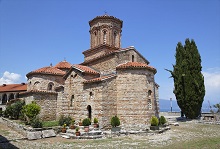
Hello. I am Yucchi, a fledgling translator who transferred last autumn from a different field. I've only just started in translation so I have much to learn, but I'm studying hard with the help of my seniors.
I was drawn to a red and yellow national flag that I found on "Nikkei Business ONLINE," and reading that article, I learned that it was the flag of Macedonia. According to the article, Macedonia was one of the slowest developing countries out of the six republics and two autonomous regions that originated after the disintegration of former Yugoslavia. However, it came in 30th place in the 2015 World Bank's "Doing Business" index, closely following Japan, which placed 29th. I was intrigued by how this country was able to achieve such remarkable growth, and decided to do a little research.
Macedonia's History and How it Achieved Its Present Rate of Growth
Looking at the map, I saw that Macedonia is located in the Balkan peninsula, and is a land-locked country, surrounded by Greece to the south, Bulgaria to the east, Albania to the west, and Serbia and Kosovo to the north. According to the Ministry of Foreign Affairs (MoFA), Macedonia's land mass is two-thirds the size of the Kyushu region in Japan.
A Newly Emerging Economic Power - Indonesia and its Language
August 7, 2017

Hello. I am Yucchi, a fledgling translator who transferred last autumn from a different field. I've only just started in translation so I have much to learn, but I'm studying hard with the help of my seniors.
In Japan, the aging population is a big problem. I saw an article the other day that said "the decrease of the population aged 15 to 64, otherwise known as the working-age population, has an impact on the economy." That got me wondering which countries had the largest working-age population, and I learned that Indonesia was attracting attention for its large population as well as its low average age. Here is what I found on Indonesia.
Indonesia, a Vibrant Developing Country with Youthful Energy
According to the website of the Ministry of Foreign Affairs, the land area of Indonesia is five times that of Japan. With 240 million people, its population comes fourth in the world after China, India, and the U.S. Contrary to Japan's seriously declining and aging population, Indonesia's population structure is an ideal pyramid, and has the potential to become an enormous market. According to "DIAMOND online," Indonesia's average age is 28. Compare that with Japan's 44, and you can get an image of how young Indonesia's population is.
"Yappango," an information site on Japanese companies' foreign ventures, explains that having many young people creates an abundant workforce, and can also stimulate an active consumer economy due to life events such as marriage, childbirth and education.
More Than Just Dialects - Differences Between Mandarin and Cantonese
July 3, 2017
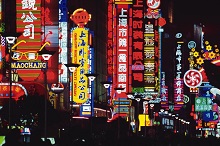
Hello, I am Yosshi. I entered the translating business two years ago, dreaming of an international career. Since then, every day I keep discovering more about the ever-fascinating world of translation.
Previously on this blog, I wrote about the differences between the two types of scripts in Chinese - simplified and traditional Chinese. Then the other day, while I was on my way back to the office after seeing a client, my supervisor asked me if I knew the differences between Mandarin and Cantonese in the Chinese language... So I decided to look it up.
Mandarin and Cantonese - Completely Different Languages
According to Ecom Chūgokugo Net, different languages are spoken in different regions of China. The first thing that popped into my mind was the difference between American and British English; even in Japan, different dialects such as Kansai dialect and Aomori dialect exist, so it's no surprise that there are many in China. However, after much research, I found out that Mandarin and Cantonese are so different to the point where it's hard to communicate between speakers of the two variations!
Tulip: The Flower that Caused the 1630s Market Bubble - Why the Netherlands' Floral Emblem is So Popular
June 26, 2017

Hello again, Naho here. Recently, apart from practising speaking English, I've started learning about investing.
After some research, I read about the era during which the Dutch were obsessive with investing, and I was astonished to find out that they all had their eyes set on tulip bulbs.
Tulips' Long-lasting Popularity in the Netherlands
It was said that although tulips were native of Turkey, ever since the 16th century when the Turkish king gave some tulip bulbs to a Dutch diplomat, tulips have been widely cultivated across the Netherlands and became their national flower.
At that time, wealthy Dutch gardeners branded themselves florists and were engaged in the breeding of different plants. Easy to grow and pleasant to the eye, tulip flowers soon gained great attention within the gardening industry, and various tulip gardens were established across the country.
Rhododendron: Nepal's Floral Emblem - The True "Flower of the Heights"
June 19, 2017

Hello again, Naho here. Did you know that August 11 is this year's "Mountain's Day" in Japan?
In Fact, Nepal's floral emblem rhododendrons are known as the "flower of the mountains" among local hikers .
Said to be the origin of the Japanese expression "flower of the heights" ("Takane no hana," often used to describe a prize beyond one's reach, an unattainable object, etc.), rhododendrons are also flowers of unexpected secrets.
Nepal's National Color: the Rhododendron Red
In Japan, rhododendrons are often grown in luxurious apartments and house gardens. With their showy, gorgeous blossoms, rhododendrons are sometimes called the "Queen of flowers," and adored by many.
Although rhododendrons grow in multiple colors such as pink, white and yellow, the type that was designated to be Nepal's national flower is the red variation called the "laliguras." To Nepali people, the red color evokes such strong feelings that it is used on their national flag. In Nepal, one can also see airplanes, sports team uniforms, etc., painted in red.
Blue Passion Flower: A Symbol of Suffering - The Surprising Origins behind Paraguay's Floral Emblem
June 12, 2017
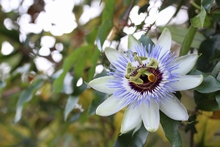
Hello again, Naho here. Time management is extremely important at work. I personally like keep a clock on my desk to remind me of how precious time is.
There is a flower that looks just like the dial of a clock, and that is the blue passion flower - which is also the floral emblem of Paraguay.
Surprisingly, however, this flower used to be associated with something distinctively different to a clock.
Blue Passion Flower: Symbol of Suffering?
With its petals resembling the short hand and the long hand of a clock, the blue passion flower looks just like a dial plate, which is why the flower is called "rokei-sou" (the clock plant) in Japanese. However, back in the day, the blue passion flower was often associated with something distinctively different.
The "passion" in "passion flower" does not mean "enthusiasm" in this context, but rather "suffering." This association came from the facts that petals of the flower form the shape of a halo and that its stamen and pistil look like the image of Jesus Christ bearing the Cross.
Plum: Taiwan's Floral Emblem with Colorful Meanings
June 5, 2017
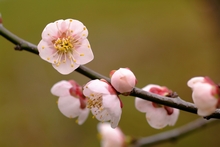
Hello again, Naho here. Just finished my work lunch - plain rice with umeboshi (pickled plum), that's the typical Japanese bento for you!
In fact, the plum flower is Taiwan's floral emblem, and it bears deep meanings to the region as a whole.
Taiwanese Values Hidden Behind the Plum
Plum blossoms usually start in February or March, when it's still very cold in the northern hemisphere . It's also said that the more bitter the weather, the more beautiful the blossoms. Perhaps through the hardy flowers of plum, Taiwanese people saw a soul that perseveres and stays strong against the nature's adversity, and thus made it their floral emblem.
Plums flowers are attributed symbolic value in the island of Taiwan. The five round petals of a plum each represent one of the five branches of the Taiwanese constitution: legislation, administration, justice, examination and inspection.
Pansy: Poland's Floral Emblem
May 29, 2017
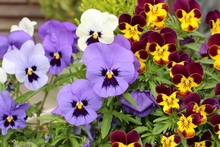
Hello again, Naho here. Do you know anyone who overthinks everything? - Well, I'm exactly like that.
Today, I would like to talk about a flower that I've always liked, and that happens to be Poland's floral emblem, the pansy.
Etymology of the Word "Pansy"
Pansies often feature some black blotches in the centre of the flower. If you stare at it from a certain distance, the black blotches may start to look like a person's forehead and chin, and some even say that they can see a person's face from the flower.
To Contact Us Regarding Our Translation Services
For urgent needs, call:
+81-3-5730-6133
